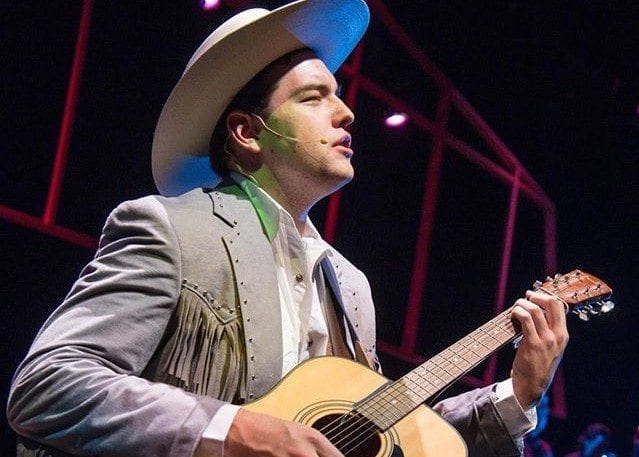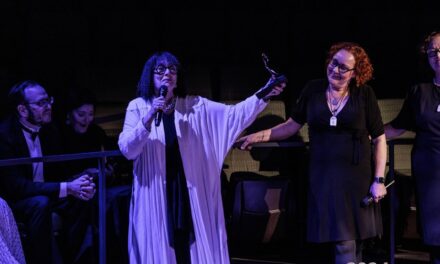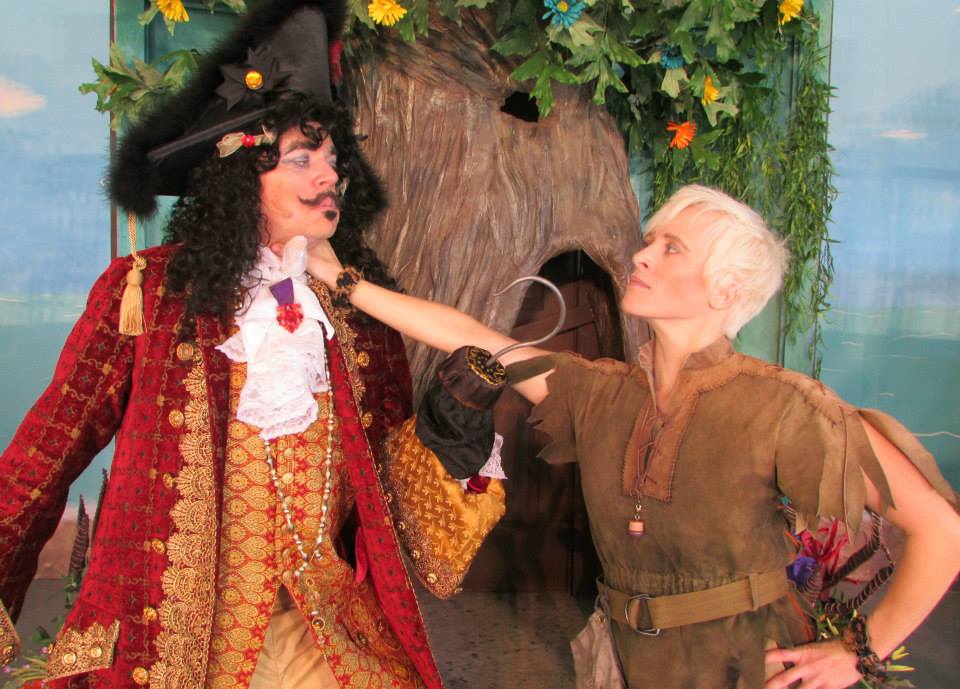CEDAR CITY — At only twenty-nine years old singer-songwriter Hank Williams died in a way sadly too familiar to the entertainment industry, an example of the dangerous combination of pain and success. Hank Williams: Lost Highway by Randal Myler and Mark Harelik features “The music and legend of Hank Williams” portrayed as a series of vignettes highlighting pivotal moments in his life and career and the observations of those closest to him. By his side in both life and on stage, Hank’s band members Hoss, Leon and Jimmy lend this production the legendary music that formed the bridge between the blues and country western. And as Tee-Tot teaches Hank to find his own song to sing, Mama Lilly, Audrey Williams, and Pappy Rose each try to steady the course of the young alcoholic star.

Christopher Whiteside as Hank Williams. Photo by Karl Hugh.
Full of chart-toppers from the early 1950’s, this production catered to a specific demographic two generations earlier than mine. In addition, this show followed a biographical plot with no clear central conflict. As a result I felt very little passion for the characters, feeling simply as though I was attending a cover-band concert of a group I’d never followed. Fortunately, when supported by the strong production quality of the Neil Simon Festival, the incredibly talented cover band led me through an enjoyable night of yodeling, heartache, and laughter.
Brandon Grayson as Hoss, Sean Militscher as Leon, and Jordan Sanders as Jimmy made up Hank’s band, The Drifting Cowboys. Trading stringed instruments throughout the evening, each contributed as strong instrumentalists and vocalists. My favorite vocal moments of the evening were when Sanders lent his tenor voice, layering a harmony above the strong melody of Christopher Whiteside as Hank Williams, the band’s frontman. Staged apart from the band, Sam Lutui as Tee-Tot added additional vocals and guitar on many numbers. While Lutui’s blues style was lacking in both intonation and articulation, Whiteside delivered a masterful yodel and a targeted blues note that hung perfectly in the ideal pocket just below the true pitch.

Photo by Karl Hugh.
Despite not being a particularly high energy show, director Peter Sham created several moments that stood out from the rest of the show’s laid-back style. One example was the subtle choreography in the number “Settin’ the Woods on Fire.” Using a tire that denoted a steering wheel and represented a few different cars throughout the evening, Mama Lilly drove while the boys sang and played. The bumps and turns and stops along the way were so synchronized that it was easy for me to suspend reality long enough to thoroughly enjoy the road trip. In other moments, Sham distributed the cast across the stage in a way that made each appear solitary. The stillness on the stage set a foreboding tone as each turned to deliver short insight into Hank’s mental state. During the final sequence of this type, I was reminded of sitting at a funeral and listening to a eulogy, wrapped up in a moment of balanced respect and regret.
Another successful element of this story was the commitment to the characters displayed particularly by Kirsten Sham, Madison Ford, and Whiteside. Kirsten Sham delivered quirky mannerisms that brought the character of Mama Lilly alive. One example was the way she appeared to chew the inside of her cheek, creating a stern face of general disapproval. In the role of Audrey Williams, Ford was given the difficult task of convincing the audience that she was a terrible singer without convincing them that she knew it. In her first solo “I’m Tellin’ You,” Ford had me right where she wanted me as I turned my head to the side unable to determine whether this was poor casting or great acting. Allowed to redeem herself a bit in the finale “I Saw the Light,” she left no room for doubt in my conclusion. Finally, as Whiteside aged from a young teen through adulthood on stage, I found myself particularly drawn to his boyhood characterization of Hank Williams. I love moments when I can identify pieces of the people in my life in the characters I see on stage. In this case it was the stiff, practiced nature of a young man with the talent to stand in front of a crowd, but none of the confidence. As he delivered “Thank God” with his shoulders hunched forward, I saw not only the young Hank Williams but the faces of so many young performers who I’ve watched take the stage for the first time.
As each scene settled into the rhythm of a country slow dance, I found myself with plenty of time to reflect on the technical aspects of the production. In particular I noted several specific instances when the effects created by Rebekah Bugg‘s lighting design gave a noticeable boost to the on stage action. In one scene, side lighting cast tall, double shadows of Hank Williams and his cowboy hat on the side walls, creating a specific concert setting. In another instance, a special light created the background of a coffee shop setting, eliminating the need for a scene change. The most influential lighting effect happened during the number “Long Gone Lonesome Blues” in which Tee-Tot instructs Hank in not only the proper way to write a song (“If you want to sing about hard times, you have to find your own”) but also how to add some style into the presentation. Unfortunately, even when leaving room to develop vocally throughout the plot, Whiteside was already a better vocalist than Lutui, which gave the song little room for growth. When Christensen’s lighting effect accentuated the “Now he’s got it!” moment, it contributed directly to the energy that carried through the song’s conclusion.
Aside from the hillbilly accent that made the diction a bit sloppy throughout the production, there was truly very little with which I could find fault. That said, there was also very little which generated a feeling of excitement or anticipation. Despite its high production and performance quality, I missed feeling passionate about the characters, feeling driven toward the resolution of a conflict, or feeling organically connected to the scenes unfolding before me. Left to wonder whether a heightened familiarity with Hank Williams or his music would have made an impact, I failed to connect this historical biography to any larger construct, and while I had a reasonably enjoyable time, I felt little more than apathy at the production’s conclusion.





